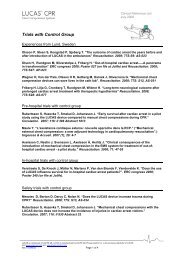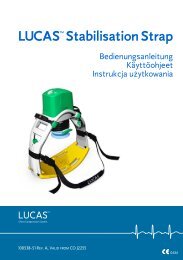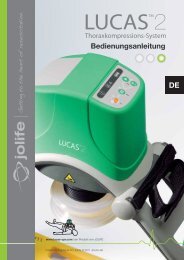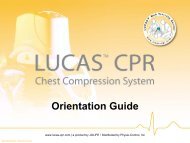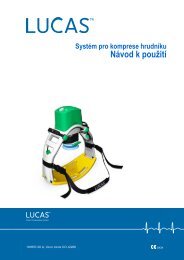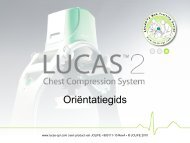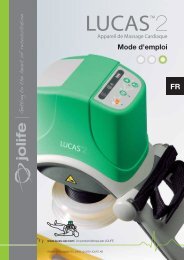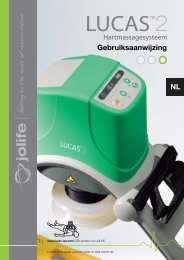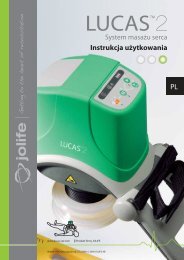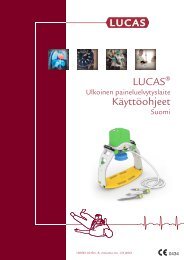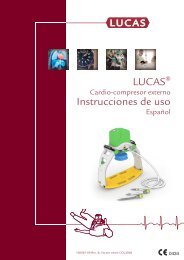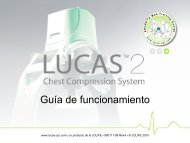LUCAS Br EN.pdf - Lucas CPR
LUCAS Br EN.pdf - Lucas CPR
LUCAS Br EN.pdf - Lucas CPR
You also want an ePaper? Increase the reach of your titles
YUMPU automatically turns print PDFs into web optimized ePapers that Google loves.
counts...<br />
Technical information<br />
Effective and uninterrupted<br />
compressions are important for survival<br />
Maintaining consistent and effective<br />
manual chest compressions<br />
is exceedingly difficult<br />
Chest compressions<br />
Rate:<br />
100 per minute<br />
Depth:<br />
~5 cm<br />
Same amount of time for<br />
compression as for decompression<br />
Allows for full recoil<br />
Patients eligible for treatment<br />
Sternum height of 17.5–30.3 cm<br />
Maximum chest width of 45 cm<br />
Power source<br />
<strong>Br</strong>eathing air from portable compressed<br />
air cylinder<br />
Air outlet in hospital/ambulance with<br />
nominal supply pressure within 3.2–6.0 bar<br />
Operation<br />
Fully pneumatic (compressed air)<br />
Air consumption:<br />
52 L/minute<br />
Operating temperature: 5 to 40°C<br />
Storage temperature: -30 to 60°C<br />
Physical characteristics<br />
Height (stowed in backpack): 65 cm<br />
Width (stowed in backpack): 33 cm<br />
Depth (stowed in backpack): 25 cm<br />
Air hose length:<br />
3.3 m<br />
Weight (unit only):<br />
6.3 kg<br />
Weight (device in backpack<br />
with included accessories): 7.8 kg<br />
All specifications are valid for <strong>LUCAS</strong><br />
Model V2 and at 25°C unless otherwise<br />
stated. Technical data are subject to<br />
changes without prior notice.<br />
When every second counts...<br />
Quality of <strong>CPR</strong> matters for return<br />
of spontaneous circulation<br />
The backboard is placed underneath the<br />
patient.<br />
The compression pad is adjusted to the<br />
patient’s chest.<br />
Piston controlled compression/decompression<br />
with suction cup.<br />
The <strong>LUCAS</strong> straps and the suction cup<br />
help maintain the position on the chest.<br />
<strong>LUCAS</strong> Regulator should be used with air<br />
cylinders to ensure correct pressure and<br />
flow.<br />
One control knob makes operation as<br />
easy as 1-2-3.<br />
For an overview of <strong>LUCAS</strong> experimental and clinical data, please turn to lucas-cpr.com<br />
or your local sales representative.<br />
www.lucas-cpr.com | a product by JOLIFE<br />
For more information, please contact the exclusive distributor Physio-Control, Inc., or the manufacturer JOLIFE AB<br />
Physio-Control, Inc., 11811 Willows Road NE, P. O. Box 97006, Redmond, WA 98073-9706 USA, Tel: +1 425 867 4000, Fax: +1 425 867 4121<br />
Physio-Control, Europe, Tolochenaz, Switzerland, Tel: +41 21 802 70 00, Fax: +41 21 802 79 00<br />
physio-control.com<br />
JOLIFE AB, Scheelevägen 17, SE-223 70 Lund, Sweden, Tel: +46 (0) 46 286 50 00, Fax: +46 (0) 46 286 50 10, E-mail: info@jolife.com<br />
jolife.com<br />
<strong>LUCAS</strong> is a trademark of JOLIFE AB. Specifications are subject to change without notice.<br />
CE 0434 © 2007 JOLIFE AB<br />
900 033-02 RevA<br />
www.lucas-cpr.com | a product by JOLIFE
Effective and uninterrupted compressions are<br />
important for survival<br />
Effective, consistent and uninterrupted<br />
compressions adhering to the Guidelines<br />
Sternal compressions; 100 compressions per minute with a depth of 5 cm. A 50/50<br />
duty cycle, i.e. equal compression and relaxation time for the chest wall. Complete chest<br />
recoil before next compression. Tireless – minimizing “no-flow” time.<br />
When every second counts...<br />
Easy to use with an intuitive design<br />
<strong>LUCAS</strong> has an ergonomic and compact design, is sturdy and yet lightweight. It is supplied in a<br />
padded backpack that is easy to carry and store.<br />
With its intuitive design, <strong>LUCAS</strong> can be applied to the patient with interruptions in compressions of less<br />
than 20 seconds, whether the patient lies on the ground, on a bed, or on a stretcher in the ambulance.<br />
AHA/ERC Guidelines for <strong>CPR</strong> (CardioPulmonary Resuscitation)<br />
2005 1,2 , emphasize the significance of compressions<br />
to provide critical blood flow to vital organs and in the end<br />
to increase the chances of a successful survival.<br />
Rescuers should:<br />
• “Push hard and push fast” in the centre of the chest at a<br />
rate of 100 per minute and with a compression depth of<br />
4-5 cm.<br />
• Take equal time for compression and relaxation.<br />
• Allow for complete chest recoil after each compression.<br />
• Compressions should be given with a minimum of<br />
interruptions.<br />
• More compressions should be provided over time; an<br />
increased compression/ventilation ratio of 30:2.<br />
Maintaining consistent and effective manual<br />
chest compressions is exceedingly difficult<br />
www.lucas-cpr.com | a product by JOLIFE<br />
Hands-free compressions for improved<br />
care and safety<br />
• The same quality for all patients and over time, independent<br />
of transport conditions, rescuer fatigue, or variability<br />
in experience level of the caregiver.<br />
• Good circulation during the patient<br />
transport process.<br />
• Safety during transportation for<br />
both personnel and patient.<br />
• Allows for defibrillation with<br />
ongoing compressions.<br />
• Frees up caregivers to focus on<br />
other life-saving tasks; ventilation,<br />
medication, defibrillation as well as<br />
decision making on continued care<br />
and therapy.<br />
• Allows for simultaneous catheterization<br />
or coronary intervention in the catheterization laboratory.<br />
<strong>LUCAS</strong> regulator<br />
<strong>LUCAS</strong> unique<br />
connector<br />
Backpack<br />
Air hose<br />
Suction cup with<br />
compression pad<br />
Operation knob<br />
Hood<br />
Patient strap<br />
Bellows<br />
Height adjustment<br />
handle<br />
Release ring<br />
Support leg<br />
Claw<br />
Backboard<br />
Stabilization strap<br />
Several studies 3,4,5,6 on the quality of compressions demonstrate<br />
the difficulty of maintaining quality even after one<br />
minute - irrespective of profession, age, gender, height or<br />
weight.<br />
• The rescuers do not accurately perceive the decay in<br />
quality themselves.<br />
• Too shallow compression depth is one of the most<br />
frequent causes of error 7 .<br />
• The hemodynamic consequences of incomplete chest<br />
recoil during the delivery of <strong>CPR</strong> may be considerable 8 .<br />
• Increasing the compression/ventilation ratio has been<br />
shown to be more tiring 9 .<br />
Quality of <strong>CPR</strong> matters for return of<br />
spontaneous circulation<br />
• <strong>CPR</strong> prolongs the time ventricular fibrillation is present<br />
and has been shown to increase the likelihood that a<br />
shock will achieve return of spontaneous circulation 1 .<br />
• The quality of <strong>CPR</strong> prior to defibrillation directly affects<br />
clinical outcomes. Specifically, longer pre-shock pauses<br />
and shallow chest compressions are associated with<br />
defibrillation failure 10 .<br />
1. 2005 American Heart Association Guidelines for Cardiopulmonary Resuscitation<br />
and Emergency Cardiovascular Care Circulation 2005;112(24):IV-25-26<br />
2. European Resuscitation Council Guidelines for Resuscitation 2005. Resuscitation<br />
2005;67S1,S13-S14<br />
3. Hightower et al. Decay in quality of closed-chest compressions over time. Ann<br />
Emerg Med 1995;26:300-303<br />
4. Ochoa et al. The effect of rescuer fatigue on the quality of chest compressions.<br />
Resuscitation 1998;37(3):149-52<br />
5. Ashton et al. Effect of rescuer fatigue on performance of continuous external<br />
chest compressions over 3 min. Resuscitation 2002;55:151-155<br />
6. Abella et al. Quality of cardiopulmonary resuscitation during in-hospital cardiac<br />
arrest. JAMA 2005;293:305-310<br />
7. Wik et al. Quality of cardiopulmonary resuscitation during out-of-hospital cardiac<br />
arrest. JAMA 2005;293:363-365<br />
8. Yannopoulos et al. Effects of incomplete chest wall decompression during<br />
cardiopulmonary resuscitation on coronary and cerebral perfusion pressures in a<br />
porcine model of cardiac arrest. Resuscitation 2005;64:363–372<br />
9. Greingor et al. Quality of cardiac massage with ratio compression-ventilation 5/1<br />
and 15/2. Resuscitation 2002;55:263-267<br />
10. Edelson et al. Effects on compression depth and pre-shock pauses predict<br />
defibrillation failure during cardiac arrest. Resuscitation 2006;71:137-145



